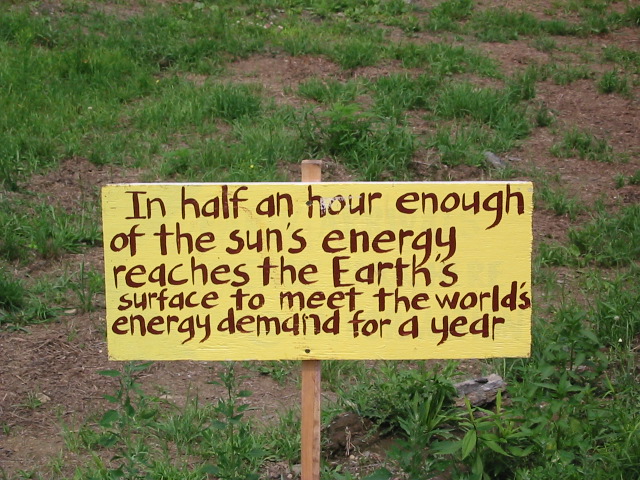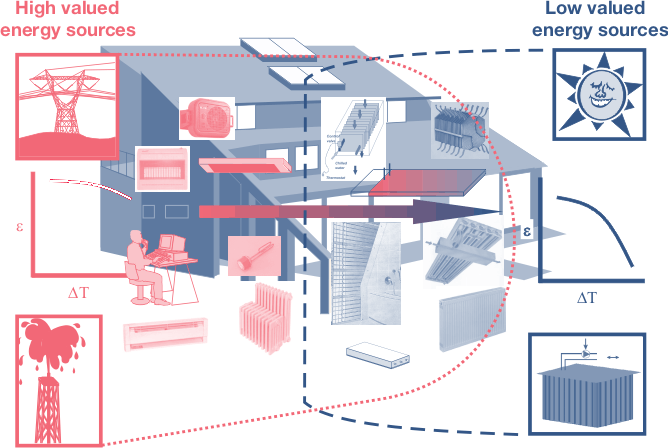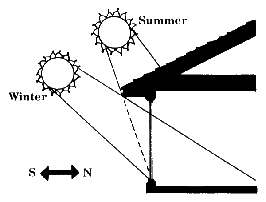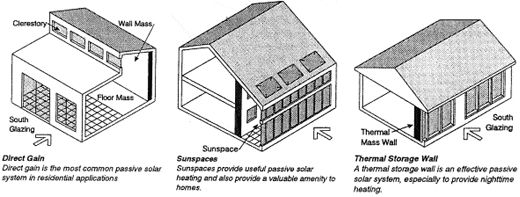Finally, a great article on the realities of built environments. Well done sir! I wish you had been able to cover natural building methods and natural community design. A modern home of the future will necessarily be made almost entirely of natural materials; to the benefit and health of our entire planet.
Blog Post
Designing Homes That Live Off Current Solar "Income"

In the last 200 years, humankind has chosen to live off the "principal" of Earth's core natural resources, not the "interest"--solar income. Here's how we can move forward with home designs that get us on a sustainable path.
[Editor's note: Robert Riversong, a Vermont builder, continues his 10-part series of articles taking design and construction to what he sees as radical or "root" concerns. Enjoy--and please share your thoughts. – Tristan Roberts]
Riversong's Radical Reflections
8. Energy & Exergy – sources and sinks
For three billion years, life has evolved on earth by capturing and converting solar energy in a most elegant and efficient manner. In fact, the green earth annually utilizes 100 terawatts (100 trillion watts), which is six times the energy consumption rate of all of humanity. We clever hominids have lived sustainably within that solar energy economy for 200,000 years. Since 8,000 years ago (the Anthropocene era), however, we've begun as a species to measurably influence the geological and biological evolution of our planet, and in the last 200 years the anthropogenic impacts of the industrial revolution and the consumption of fossil fuels have had impacts on earth's climate and the evolution of life which may very well extend hundreds of thousands if not millions of years into the future.
Because we have chosen to spend the earth's energy capital rather than live--like the rest of life--off the annual income, the hundred million tons of human biomass on earth, along with 700 million tons of domesticated animals and 2 billion tons of crops are competing with the remaining 5–30 million species of life for land and energy. The result is an unprecedented loss of biodiversity at a rate 100–1,000 times background levels, with the prospect of the extinction of half of all living species in the next 100 years--a disaster known as the Holocene extinction, the first in the history of earth caused by a single dominator species.

You might think that, with our oversized brains, we would not act so stupidly. And yet, here we are! While it's not possible to reverse the damage we've already initiated, we can at least attempt to reduce further impacts by a new ethic of conservation.
SUPPORT INDEPENDENT SUSTAINABILITY REPORTING
BuildingGreen relies on our premium members, not on advertisers. Help make our work possible.
See membership options »Sources & Sinks--Energy & Exergy
When we do a heat loss analysis of a house design, we calculate only the quantity of energy required at the point of use and rarely consider the quality of our energy sources. We know from the laws of thermodynamics that energy cannot be created or destroyed, only converted from one form to another, and that higher energy states resolve into lower energy states by the universal process called entropy.
Since we cannot either create or destroy energy, we can neither consume it nor conserve it. What we consume (or not) is order or--in thermodynamics--exergy, which is the opposite of entropy or disorder. The reason that modern humanity is facing the dual crises of fossil fuel depletion and global warming (in addition to general resource depletion, biodiversity loss, pollution and disease) is because of our short-sighted and rapid consumption of highly ordered, or concentrated, exergy in the form of dead dinosaurs and stardust uranium. In just a couple hundred years, we have nearly consumed all the exergy that the universe took 4.5 billion years to accumulate here on earth.
Life is the only anti-entropic agency in the Universe, converting the low-exergy energy of the sun and simple molecules into highly ordered and complex biological creatures, but we're working counter to evolution unless we more properly match our energy sources to our energy sinks in terms of exergy--concentration or quality. In other words, if we need to keep our homes at a modest 70° or so, or heat our water to 140° (to keep it sterile), then we don't need to use a nuclear fission reaction at several thousands of degrees or even a coal, oil or gas fire at several hundreds of degrees. A far better match of input to output would be direct solar conversion, as passively as possible. (By the way, uranium contains about 17,000 times the energy of even extremely concentrated coal, by weight, and the uranium fuel cycle contributes as much CO2 per kWh produced as natural gas--so it makes sense neither from an exergy nor from a global warming perspective, never mind the dangers of radiation and the impossibility of safe storage of spent fuel for 10,000 years).
Passive Solar--Elegant Simplicity
Clearly, the most sustainable option for space heating and hot water is passive solar and solar thermal collectors, and for cooling and ventilation it's low-absorption surfaces, shading and cross-ventilation, evaporative cooling (such as roof ponds or living roofs), or very efficient fans operated by photovoltaics. An extremely well insulated house, even in cold and cloudy New England, can source 30% to 50% of its heating needs from free direct sunlight stored diurnally in appropriate thermal mass. To design a house that's NOT passive solar amounts to a crime against nature.
For the limited purposes of this essay, I will focus on the most simple and cost-effective solar energy capture technology: passive solar. For the most part, passive solar construction is a matter of using that big brain for clever design, and humans have been utilizing this for thousands of years. Nearly two and a half millennia ago, the Greek philosopher Aeschylus wrote, "Only primitives & barbarians lack knowledge of houses turned to face the winter sun." What he didn't know was that "primitives," such as the Anasazi (or Pueblo) people of the American southwest, used the same principles as much as 12,000 years ago.
The elements of good passive solar design include: southerly orientation (within 15° of true south), an elongated south façade, simple geometry, an open floor plan, sufficient south glazing (7%-12% of floor area) with well-insulating but highly solar spectrum open glass (SHGC 0.50 or higher), appropriately sized direct-gain thermal mass for diurnal storage and release, and overhangs or other shading engineered for the latitude (sun angles) to allow entry of winter sun and blockage of summer sun

Effective utilization of free solar heat also requires a very well-insulated building envelope so that the sun can provide a significant percentage of the daily heat load of the house. In cold climates, I would not use less than R-40 walls and R-60 ceilings, and double-frame walls and flat ceilings, insulated with cellulose, provide the most cost-effective strategy for a super-insulated structure that does not require high-exergy materials (such as rigid or sprayed petrochemical foams) to retain low-exergy heat. Strawbale construction with earthen plasters is another low-exergy option.

In addition to this elegantly simple direct-gain method of capturing solar energy, there are also indirect-gain approaches (such as thermo-siphoning air panels and Trombe walls) and isolated-gain methods (such as attached sunspaces or greenhouses), but neither of the latter are as energy-efficient or cost effective as south windows backed by some additional thermal mass. The mass is ideally in the path of the sun, with a low-specularity, highly absorptive (rich-colored) surface, high thermal capacity, moderate conductivity, and 4" thick as a floor or 8" thick as an interior wall. The thermal mass, if it's in the floor, has to also be well-insulated from the ground – though less so than the walls or ceilings because the earth is not as cold as outside winter air and because some earth-coupling helps make the building frost-proof.
In just a few generations, we have shifted from being an "earth-coupled" species to a global culture that uses materials, techniques and technologies to isolate ourselves from the life-giving and life-enhancing qualities of this sunlit planet. In so doing, we have also decoupled ourselves from the wisdom that allowed us to live sustainably within the biosphere for so many millennia.
It's time we return to earth, come back to our senses, and become agents rather than enemies of evolution. There's nothing more intelligent than being in sync with the planet.
1. Context – land, community & ecology
2. Design – elegant simplicity, the Golden Mean
3. Materials – the Macrobiotics of building: natural, healthy and durable
4. Methods – criteria for appropriate technology
5. Foundations – it all starts here: how do we begin?
6. Envelope – shelter from the storm, our third skin
7. HVAC – maintaining comfort, health and homeostasis
8. Energy & Exergy – sources and sinks
9. Hygro-Thermal – the alchemy of mass & energy flow
10. Capping it All Off – hat & boots and a good sturdy coat
copyleft by Robert Riversong: may be reproduced only with attribution for non-commercial purposes
Robert Riversong has been a pioneer in super-insulated and passive solar construction, an instructor in building science and hygro-thermal engineering, a philosopher, wilderness guide and rites-of-passage facilitator. He can be reached at HouseWright (at) Ponds-Edge (dot) net. Some of his work can be seen at BuildItSolar.com (an article on his modified Larsen Truss system), GreenHomeBuilding.com (more on the Larsen Truss), GreenBuildingAdvisor.com (a case study of a Vermont home), and Transition Vermont (photos).
Published June 30, 2011 Permalink Citation
(2011, June 30). Designing Homes That Live Off Current Solar "Income". Retrieved from https://www.buildinggreen.com/news-article/designing-homes-live-current-solar-income
Comments
It would be nice to see a pro
It would be nice to see a program sponsored by the gov. or others who could help
people who have lost their homes the chance to restart and do it green. Are we
as Americans personally responsibl for the downfall of the economy? We have to re-start
the economy somewhere. Trashed houses and properties that have been vacated that
need 1m's of $ worth of rehabilitation could easily be targeted to get the ball rolling.
Not sure of the logistics to do so but think it would give an opportunity to put it in our eyes. Imagine just one house in each community that has been vacant for a long period and someone having the opportunity to build a green home in it's place. If there were
some sort of rebate to make it doable I think we could get this flowing at a faster rate.
Better idea than selling a property for a a buck o be rehabbed.
Earthman, I agree that we nee
Earthman,
I agree that we need to return to using the materials that our local environment provides, and we need to use them much more conservatively. In the Northeast US, the most available natural building material is still wood from well-managed forests. And I continue to believe that, as long as paper waste is still available, cellulose insulation is the best of the options. But straw bale and earthen plasters with lime wash are increasingly viable in this wet and cold climate, though most natural builders are also using non-natural materials to attempt to make them air and water tight and meet modern code standards.
As much as we need to return to local and natural materials, we may also have to let go of the notion of the "modern house" - which has become a highly-controlled artificial life-support environment with all the comfort and convenience we have come to demand. What we need is shelter - the rest is optional.



Add new comment
To post a comment, you need to register for a BuildingGreen Basic membership (free) or login to your existing profile.